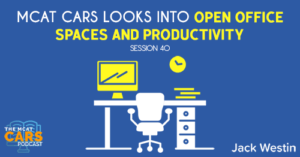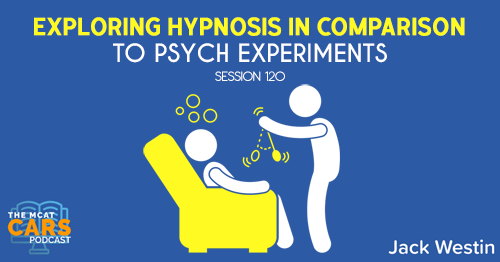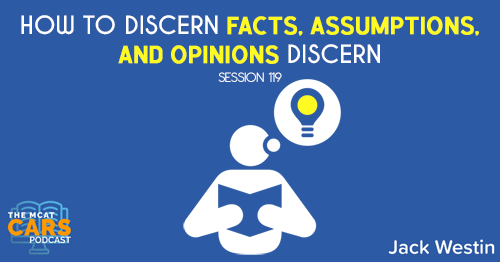Apple Podcasts | Google Podcasts

Session 40
Office walls are a thing of the past, and cubicles are distant memories. How do open offices impact productivity, and do headphones reduce distractions?
Jack Westin joins us once again for another episode. If you’re struggling for some help on tour MCAT CARS section, sign up for their free CARS Daily Passages and they will be sent right into your inbox, everyday.
Listen to this podcast episode with the player above, or keep reading for the highlights and takeaway points.
Link to article:
https://www.theatlantic.com/health/archive/2019/04/airpods-open-plan-offices/588112/
Once upon a time, offices had walls inside them. They weren’t glass, like the conference rooms of 2019, but were made of drywall, and were usually painted a neutral color, like many of the walls you know and love. Over time, office walls gave way to cubicles. Now, for many office workers, the cubicles are also gone. There are only desks.
If you’re under 40, you might have never experienced the joy of walls at work. In the late 1990s, open offices started to catch on among influential employers—especially those in the booming tech industry. The pitch from designers was twofold: Physically separating employees wasted space (and therefore money), and keeping workers apart was bad for collaboration. Other companies emulated the early adopters. In 2017, a survey estimated that 68 percent of American offices had low or no separation between workers.
Now that open offices are the norm, their limitations have become clear. Research indicates that removing partitions is actually much worse for collaborative work and productivity than closed offices ever were. But something as expensive and logistically complicated as an office design is difficult to walk back, so, as Jeff Goldblum wisely intones in Jurassic Park, life finds a way. In offices where there are no walls, millions of workers have embraced a work-around to reclaim a little bit of privacy: wireless headphones.
The arrival of these now-ubiquitous devices has ushered in a new era of office etiquette—and created a whole new set of problems.
Unlike their tethered forebears, Bluetooth wireless headphones are convenient because they allow workers to forget they’re wearing a device and to leave their desk without yanking their laptop onto the floor. In open offices, people commonly wander around with their headphones on all day, into bathrooms and kitchens, sometimes listening to nothing at all in order to avoid the constant distraction of compulsory social interaction.
We have Apple to thank for wireless headphones’ proliferation. The tech giant launched its tiny white AirPods in late 2016 to accompany new iPhones that lacked a traditional headphone jack. Despite initial concern that having two plastic sticks poking out of your ears might look insurmountably lame, AirPods have avoided the demise of other wearable tech such as Google Glass by being immediately useful. Industry analysts estimate that tens of millions of pairs of AirPods have been sold already, accounting for as much as 85 percent of the wireless-headphone market. The earbuds even star in ultra-viral videos and TikTok memes as a jokey symbol of wealth among teens.
[02:26] Paragraph 1, Sentence 1
Once upon a time, offices had walls inside them.
Jack says:
This could be referring to the office building. Let’s read on to find out more about this.
[02:57] Paragraph 1, Sentence 2
They weren’t glass, like the conference rooms of 2019, but were made of drywall, and were usually painted a neutral color, like many of the walls you know and love.
Jack says:
The author is painting a picture of conference rooms in 2019 of them being made of glass. Previously, they were neutral-painted dry walls.
[03:22] Paragraph 1, Sentence 3
Over time, office walls gave way to cubicles.
Jack says:
Walls were removed to make room for cubicles. So “gave way” here means “replaced.”
[04:04] Paragraph 1, Sentences 4-5
Now, for many office workers, the cubicles are also gone. There are only desks.
Jack says:
Now, we’re left with nothing but desks. The author gives a timeline here of a progression of offices.
You may not be interested in how offices evolve over time. But you need to visualize it so you can find interest in what you’re reading. Get a sense of what it looks like to have walls in the office – and then glass, to cubicles, to none. It’s like a library.
'You need to find some interest in what you're reading. The best way to do that is to visualize it.'Click To Tweet[05:28] Paragraph 2, Sentence 1
If you’re under 40, you might have never experienced the joy of walls at work.
Jack says:
Because today’s offices have no walls, maybe the author is yearning for the past. Maybe walls are okay to have and people enjoyed them in the past. Or maybe the author is being sarcastic and trying to point out that you really don’t want walls. Let’s keep reading.
[06:37] Paragraph 2, Sentence 2
In the late 1990s, open offices started to catch on among influential employers—especially those in the booming tech industry.
Jack says:
Open offices here would mean having no walls and cubicles. So they’re using a different term here to describe this. You have to pick up on this as you read.
[07:31] Paragraph 2, Sentence 3
The pitch from designers was twofold: Physically separating employees wasted space (and therefore money), and keeping workers apart was bad for collaboration.
Jack says:
Now, the author is bringing up potential reasons for open offices.
[07:50] Paragraph 2, Sentence 4
Other companies emulated the early adopters.
Jack says:
The early adopters are the tech industry and now saying that other companies are doing it as well.
[08:08] Paragraph 2, Sentence 5
In 2017, a survey estimated that 68 percent of American offices had low or no separation between workers.
Jack says:
We’re given here the statistics of open spaces in America. And it shows that it’s popular.
[08:35] Paragraph 3, Sentence 1
Now that open offices are the norm, their limitations have become clear.
Jack says:
The author is giving another angle to the topic. It’s a common way of how passages work. They establish what’s going on, how that’s great, then talk about how bad it is.
So why do they bring up the positives only to go to the negative side? Maybe the author wants the readers to anchor their thoughts around the good and then point out how they’re not good. So it’s relative.
But why can’t the author directly tell us it’s bad? Basically, it’s making the author seem more reasonable. But if you’re not open to that and you don’t see that, then you could be confused. They want to seem more reasonable and less biased when they end up saying it’s bad.
[11:18] Paragraph 3, Sentence 2
Research indicates that removing partitions is actually much worse for collaborative work and productivity than closed offices ever were.
Jack says:
Now the author is saying that’s there’s research suggesting that removing the partitions is bad.
[11:49] Paragraph 3, Sentence 3
But something as expensive and logistically complicated as an office design is difficult to walk back, so, as Jeff Goldblum wisely intones in Jurassic Park, life finds a way.
Jack says:
“Life finds a way” may mean that the “walls” will find a way. So you can walk back in a sens
[12:38] Paragraph 3, Sentence 4
In offices where there are no walls, millions of workers have embraced a work-around to reclaim a little bit of privacy: wireless headphones.
Jack says:
The author is saying that because to go back and put up walls in the expensive and logistically complicated, people are wearing headphones. It kind of simulates the wall experience that it separates us.
[13:25] Paragraph 4, Sentence 1
The arrival of these now-ubiquitous devices has ushered in a new era of office etiquette—and created a whole new set of problems.
Jack says:
It’s a new way of working and it’s somehow creating problems as the author suggests.
[14:05] Paragraph 5, Sentence 1
Unlike their tethered forebears, Bluetooth wireless headphones are convenient because they allow workers to forget they’re wearing a device and to leave their desk without yanking their laptop onto the floor.
Jack says:
The author talks about the convenience of wireless headphones.
[14:34] Paragraph 5, Sentence 2
In open offices, people commonly wander around with their headphones on all day, into bathrooms and kitchens, sometimes listening to nothing at all in order to avoid the constant distraction of compulsory social interaction.
Jack says:
The author is pointing out what is happening in the offices and people just wearing them all day long. They just want to get that “wall” back by having headphones on.
[05:12] Paragraph 6, Sentence 1
We have Apple to thank for wireless headphones’ proliferation.
Jack says:
It just means that wireless headphones are becoming more and more popular.
[15:38] Paragraph 6, Sentence 2
The tech giant launched its tiny white AirPods in late 2016 to accompany new iPhones that lacked a traditional headphone jack.
Jack says:
This is just a bit of a history as to when these headphones came out.
[15:53] Paragraph 6, Sentence 3
Despite initial concern that having two plastic sticks poking out of your ears might look insurmountably lame, AirPods have avoided the demise of other wearable tech such as Google Glass by being immediately useful.
Jack says:
The author is saying that while people are worried they looked bad, but because they’re useful, they are popular.
[16:19] Paragraph 6, Sentence 4
Industry analysts estimate that tens of millions of pairs of AirPods have been sold already, accounting for as much as 85 percent of the wireless-headphone market.
Jack says:
They’re giving us numbers of how popular they are.
[16:33] Paragraph 6, Sentence 5
The earbuds even star in ultra-viral videos and TikTok memes as a jokey symbol of wealth among teens.
Jack says:
This is another example of how popular wireless earphones are.
[17:17] The Main Idea
So the main idea here is that wireless headphones are somewhat a response to this changing office condition. They bring back the office they miss.
[18:31] Possible MCAT Question
For which of the following conclusions does the passage offer the most support?
(A) New technology tends to make workers less productive, not more.
(B) In the future, open offices will become less common.
(C) Workers work better when they have some time to themselves.
(D) Many companies provide Apple Airpods to their employees.
[19:05] Thought Process in Answering the Question
The question asks for the conclusion here so it doesn’t really have to be a direct statement in the passage.
The key here is to not try so hard. Think about which once was discussed and what’s more likely discussed. So even though none of these was mentioned directly, which one was more likely to be discussed by the author.
Looking into answer choice A, the author is saying that the earphones are actually helping them. And they want to go back to being along. It’s not actually bad, but good. So new technology is making them more productive. Having no walls is not technology but design. So A doesn’t make sense here.
For D, it’s obviously something that we can not conclude. There’s no way for us to say that companies are going to buy AirPods for their employees. It’s a play on the last paragraph actually. But the passage doesn’t suggest that AirPods are the remedy for every company. So D is crossed out here.
Now, we’re down to B and C.
B is saying that they don’t have open offices anymore. We said open offices are bad. But we didn’t say we’re going back to the older kinds of offices. In fact, the passage says it’s hard to do. Instead, the author proposes that we’re bringing that condition back by wearing headphones. So B here contradicts the author’s point.
C is the better choice here. It wasn’t directly said in the passage but the author suggested that open offices lead to more distraction. We can then assume, people become less productive with open offices because we end up spending too much time with other people.
Therefore, “having time to themselves” is something that can happen because we’re talking about avoiding people throughout the passage.
The whole point of headphones was to allow us to bring back the condition. We’re trying to avoid social interaction. It suggests we’re probably better off working by ourselves. Hence, C is the best choice here.
[26:36] Key Takeaways
Do not look at an answer and start justifying it could be right. Instead, look at the answers you’re stuck on and think which would the author go for. Which one sounds like the author would say? And this will usually lead you to the better answer?
[27:00] Jack Westin
Check out Jack Westin and see how he can help you with your CARS prep. Remember, learning how to do well on the CARS section will help you with every section of the MCAT. What it all comes down to is comprehending what you’re reading.
Links:
Link to article:
https://www.theatlantic.com/health/archive/2019/04/airpods-open-plan-offices/588112/
SEARCH SITE
SEARCH SITE
LISTEN FOR FREE











